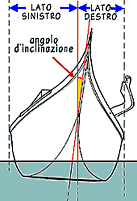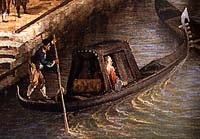Some friends of mine are going to Venice in couple of months, and they told me that they're probably going to take a gondola ride. We were talking about the gondolas, and and how they work and all that, and we realized we were guessing about much of it. So I want to know the facts. How does one hail a gondola? How much does it cost? Do the gondoliers have to be licensed? How is a gondola different from a water taxi? As you can see, I have many questions.

Despite the colorful covers, all Venetian gondole are black.
This is thanks to a decree passed by the Doge in 1562,
which said that only gondole that transport important personages
may be colored. (Photo from Life in Italy)
- Generally speaking, there are two types of gondolas:
- Charterage gondole -- gondolas for hire, mostly used by tourists or married couples, etc.
- Gondole de parada -- ferries used by Venetians trying to cross canals to get from one place to another
- Before I get into details about these two types of gondole, it is important to know something about the canals in Venice.
- Venice is an island -- or more accurately, 100 islands -- shaped sort of like your clenched right fist and forearm. Canals snake and criss-cross through nearly every part of the island. But the biggest one snakes through the center of the fist. This canal is called the Grand Canal.
- There are also smaller islands around the edges of Venice, and the waters that separate Venice from these other islands are also called canals.

Sorry this map looks a little funny, but it was the best one I could find
that shows the Grand Canal and the smaller and outer canals as well.
You can see this map in its original, much larger version,
which also allows you to click to view more detail at Venice Online.
- So you can see how important it would be for people to use the ferries to get from one place to another on a regular basis.
- Costs 50,000 Eurocents. I think that would be 5 Euros? Or roughly $7?
- There are six major ferry routes. They each take rather winding courses across the island and make several stops along the one. One route goes from the railway station (ferrovia) to St. Mark's Square (Piazza San Marco), which is one of the most famous tourist locations in Venice. That route crosses the Grand Canal but does not follow it.
- For details about each itinerary, go to the Official Gondola Site and click on the route of interest. Within that route's page are links to specific stops along the way.
The tourist gondolas, or charterage gondole
- Some of these gondolas are equipped with luxuries such as carpets, stuffed seats, painted brass figures, and other embellishments.
- A 40-minute, standard tour during the day costs 80 Euros (about $110).
- If you want to take an extended trip, each extra 20 minutes will cost you an additional 40 Euros (~$55).
- Nighttime tours for the same lengths of time cost 100 Euros (~$137), plus 50 Euros (~$69) for each additional 20 minutes.

This canal in the San Marco district has a bit of a fondamente
on the left, and no shore on the right. Based on the pictures
I saw, most of the canals do not have a shore.
(Photo by Marpessa, 2005)
- If you do take a tour, try to choose a route that has fondamente, or shores on the sides of the canals. Canals without fondamente lap right up against the edges of buildings and give a somewhat more claustrophobic view, while canals with shores have a little more breathing room, let you see the people walking by, and generally provide a more extended view of the surroundings.
- If you get a singing gondolier, the songs he'll sing are from Naples, not Venice. This is one reason why the native Venetians don't like the singing gondoliers.
- Gondolas are built with the left side slightly larger than the right, which helps to counterbalance the weight of the lone gondolier. This means the craft will always list slightly farther to one side.

With a slightly wider hull on the left,
the gondola lists to the right.
(Diagram from the Official Gondola Site)
- The bottom of the gondola is flat, which allows it to navigate even the shallowest waters.
- Gondolas can be as large as 11 meters long and weigh 60 kilos (132 lbs), but they can still be propelled by one person using a single oar.
- The boat is made almost entirely of wood, with the exception of the head and the risso at the stern. The head's purpose is to help balance the boat, but its particular curvature is traditionally designed to represent the shape of the Grand Canal. Other decorative elements represent the six districts of Venice, the Rialto bridge, and other Venetian landmarks.
- Gondolas used to have an enclosed cabin, or felze, that allowed people to travel without being seen. These types of gondolas were often hired for romantic or illicit purposes.

Gondola with felze, or cabin.
Who knows what went on inside those felzes?
(Image from the Official Gondola Site)
- The Society of Gondoliers is based on the traditional guild, like an artisans' guild, which all respectable gondoliers have joined. To be granted membership, you have to pass a driver's test, so to speak. You don't have to speak Italian, but it will probably help you get around more easily.
- Back in the day, guild members were required to give aid to "fugitive nuns" and they could be conscripted to serve in the Venetian navy.
- Gondoliers have all been men until 2007, when Alexandra Hai, a 35 year-old woman from Germany, became the first female gondolier in Venetian history.
- However, the Society of Gondoliers revoked her license, claiming she is not strong enough to operate her gondola. She failed her test three times, but passed on her fourth attempt. She also passed the written exam.
Sources
Official Gondola Site (English version)
VeniceWord, gondola
Teresa Cutler, "Gondolas: Venice in Black," Life in Italy
Kate Connolly, "Woman causes storm on Venice's Grand Canal," The Guardian, April 5, 2007
Judy Johnson, The Gondoliers of Venice: Co-operative Tradition Under Threat on the Grand Canal, ACCORD CASC Presentation, May 2005
"Rowing your boat - tips on becoming a Venetian gondolier," Insight on the News, September 6, 1999


Thanks Juliet! This blog was great, and will be very helpful when we go to Venice. If we get serenaded, we will think of you the whole time. :)
ReplyDeleteLove,
Mark & Jarred